1. Introduction
The cosmetics and skin care industry is experiencing a profound transformation, driven by the integration of nanotechnology into product development and formulation. Nanotechnology, the science of manipulating matter at the atomic and molecular scale (typically 1–100 nanometers), is enabling unprecedented advances in product efficacy, safety, and consumer experience. From anti-aging serums and sunscreens to hair care and makeup, nanotechnology is redefining what is possible in beauty and personal care. This article provides an in-depth, evidence-based exploration of nanotechnology’s impact on cosmetics and skin care, covering scientific principles, applications, benefits, safety, regulation, market trends, and future directions, with examples from leading brands and innovators.
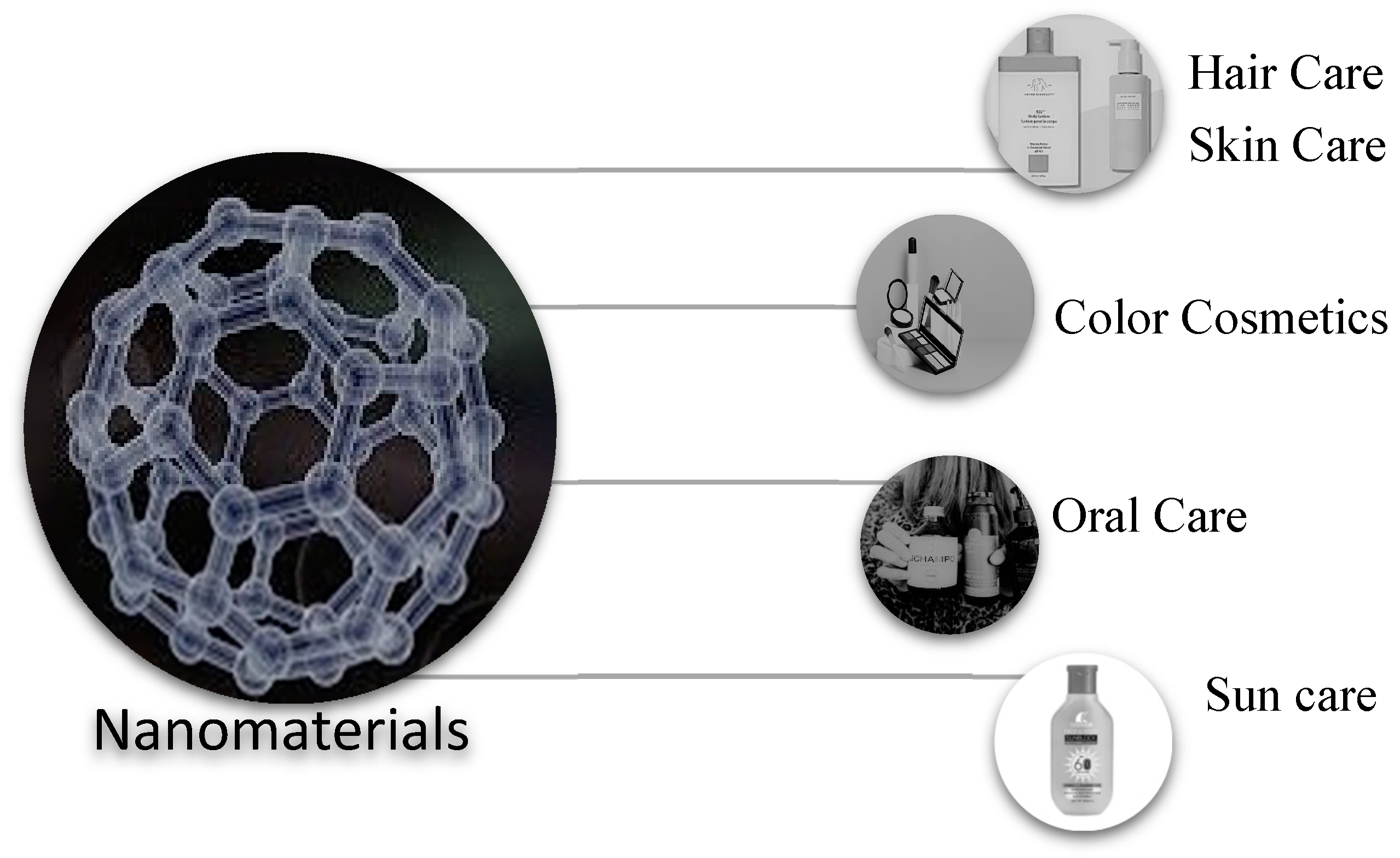
2. The Science of Nanotechnology in Cosmetics
What Are Nanomaterials?
Nanomaterials are materials with at least one dimension in the nanometer range (1–100 nm). At this scale, materials exhibit unique physical, chemical, and biological properties, such as increased surface area, enhanced reactivity, and improved penetration through biological barriers. These attributes are particularly valuable in cosmetics, where efficacy, stability, and targeted delivery are crucial.
Types of Nanomaterials Used in Cosmetics
Liposomes: Spherical vesicles that encapsulate both hydrophilic and hydrophobic ingredients, improving their delivery and stability.
Nanoemulsions: Fine dispersions of oil and water that enhance the solubility and absorption of active ingredients.
Solid Lipid Nanoparticles (SLNs): Solid fat-based carriers that protect sensitive ingredients and enable controlled release.
Nanocapsules: Polymeric shells that encapsulate active substances for sustained and targeted delivery.
Niosomes: Non-ionic surfactant-based vesicles, similar to liposomes, used for encapsulation and delivery of actives.
Nanocrystals: Pure active ingredients in nanometer-sized crystalline form, increasing solubility and absorption.
Metal Nanoparticles: Gold, silver, and other metals used for their antimicrobial, antioxidant, and sensory properties.
Nano-sized Titanium Dioxide and Zinc Oxide: Widely used in sunscreens for transparent, non-whitening UV protection.
3. Market Growth and Industry Dynamics
The global nanotechnology in cosmetics market is expanding rapidly, reflecting both consumer demand and technological innovation. In 2024, the market was valued at $8.36 billion and is projected to reach $9.73 billion in 2025, growing at a compound annual growth rate (CAGR) of 16.4%. By 2029, the market is expected to hit $17.73 billion, driven by rising R&D investment, consumer awareness, and sustainability initiatives.
Key Market Drivers
The rapid expansion of the nanotechnology in cosmetics market is underpinned by several powerful drivers, each reflecting evolving consumer expectations, advances in science, and industry adaptation. Below are the principal factors fueling this growth, supported by the latest research and market analysis.
- Consumer Demand for Advanced Skincare
Consumers are increasingly seeking cosmetic products that deliver superior efficacy, faster visible results, and are backed by credible scientific advancements. This shift is particularly pronounced in the skincare segment, where buyers are drawn to formulations promising deeper penetration, longer-lasting effects, and multi-functionality. Nanotechnology enables the development of such high-performance products, meeting the rising expectations for both effectiveness and convenience.
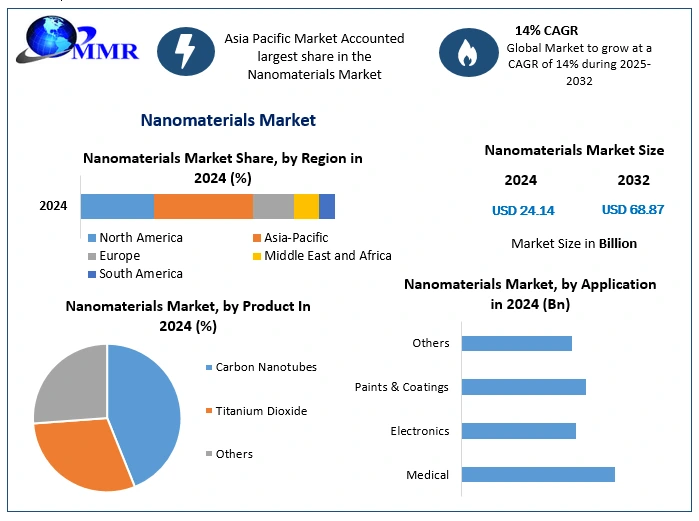
- Ingredient Efficacy and Innovation
Nanotechnology significantly enhances the bioavailability and targeted delivery of active ingredients. Nanocarriers such as liposomes, nanoemulsions, and nanocapsules allow for deeper skin penetration and controlled release, ensuring that potent actives like vitamins, peptides, and antioxidants are delivered exactly where they are needed for optimal effect. This innovation enables brands to offer products that are not only more effective but also longer-lasting and safer, as lower concentrations of actives can achieve better results.
- Regulatory Approvals and Standards
Growing regulatory oversight is fostering trust and encouraging further innovation in the industry. Regulatory bodies in the US, EU, and other regions require thorough safety assessments, clear labeling, and, in some cases, pre-market approval for nanomaterials used in cosmetics. These standards ensure consumer safety and product transparency, which in turn builds consumer confidence and supports market growth. For example, the EU mandates that nano-ingredients be clearly labeled and undergo safety evaluations before being used in products.
- Sustainability and Green Beauty
There is a marked increase in consumer demand for green, ethical, and sustainable beauty products. Nanotechnology supports the creation of high-performance formulations using fewer or more sustainable ingredients, such as plant-based or biodegradable nanomaterials. This aligns with eco-conscious values and the clean beauty movement, as consumers prefer products that are both effective and environmentally responsible. The use of by-products and natural ingredients in nanotechnology formulations further contributes to a circular economy and reduced waste.
According to The Soil Association’s Organic Beauty and Wellbeing Market Report (March 2024), the UK saw a 65% growth in organic mother and baby care and a 6% rise in organic health and personal care, underscoring the strong demand for ethical and sustainable beauty solutions.
- Brand Differentiation
In an increasingly crowded market, brands leverage nanotechnology to distinguish themselves. By offering unique claims—such as superior ingredient delivery, multifunctionality, and visible results—companies can capture consumer attention and foster loyalty. Innovative use of nanotechnology not only enhances product performance but also strengthens brand image and competitive advantage.
- Additional Influencers
Research and Development Investment: Ongoing R&D is leading to the launch of novel nanotechnology-based products, such as advanced anti-aging serums, targeted eye care, and customizable skincare solutions.
Consumer Awareness:As knowledge about the benefits of nanotechnology in cosmetics spreads, more consumers are willing to try and invest in these advanced products.
Ethical Sourcing and Transparency: Brands that emphasize ethical ingredient sourcing, cruelty-free practices, and clear labeling are more likely to gain consumer trust and market share.
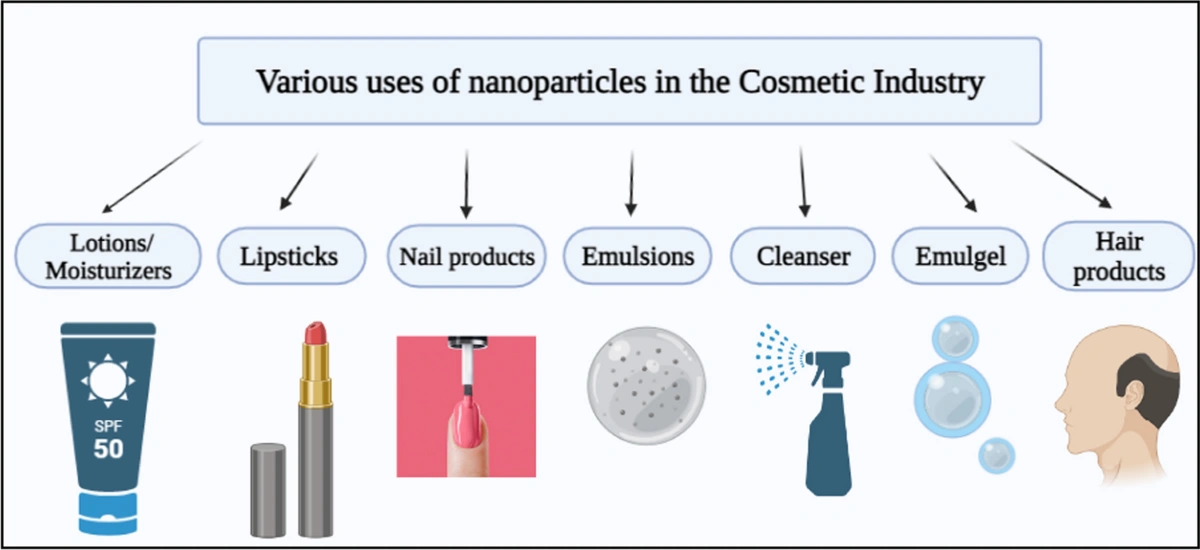
4. Applications of Nanotechnology in Cosmetics and Skin Care
Skin Care
• Anti-Aging Products
Nanotechnology is revolutionizing anti-aging by enabling deeper and more targeted delivery of active ingredients such as retinol, peptides, coenzyme Q10, and antioxidants. Nanocarriers protect these sensitive molecules from degradation and facilitate their penetration into the deeper layers of the skin, where they can stimulate collagen production, reduce wrinkles, and improve elasticity.
Brand Example: Lancôme’s Hydra Zen and the Power of Nanocapsules
Lancôme’s Hydra Zen line showcases the sophisticated use of nanocapsules in skincare. These microscopic carriers are designed to encapsulate peptides and moisturizing agents, gradually releasing them over time. This controlled delivery system ensures that active ingredients penetrate deeper layers of the skin while minimizing surface degradation or irritation.
From a packaging standpoint, products like Hydra Zen require:
- High-barrier containers to protect nanocapsules from oxidation or light degradation
- Airless pumps to maintain the purity and potency of encapsulated actives
- Opaque or tinted packaging to prevent UV-induced breakdown
• Moisturizers and Serums
Nanocarriers like liposomes and nanoemulsions enhance hydration by delivering humectants and emollients more efficiently, resulting in longer-lasting moisture and improved skin barrier function.
Brand Example: Sesderma’s Liposomal Delivery System for Hyaluronic Acid and Vitamin C
Spanish dermocosmetic brand Sesderma is a pioneer in applying liposomal nanotechnology across its skincare lines. In products like C-Vit and Acglicolic, Sesderma encapsulates active ingredients—such as hyaluronic acid and vitamin C—within liposomes, allowing them to penetrate deeper into the skin’s layers.
Liposomes are tiny spherical vesicles with a lipid bilayer structure that mimics cell membranes. This similarity enables them to fuse with skin cells, enhancing ingredient absorption and ensuring greater stability of sensitive actives like vitamin C, which is typically prone to oxidation.
To protect the integrity of these sensitive nanoformulations, Sesderma uses:
- Air-tight, UV-resistant packaging to prevent ingredient degradation
- Dropper bottles or airless dispensers for precision and hygiene
- Multilayered packaging materials to ensure minimal exposure to oxygen and light
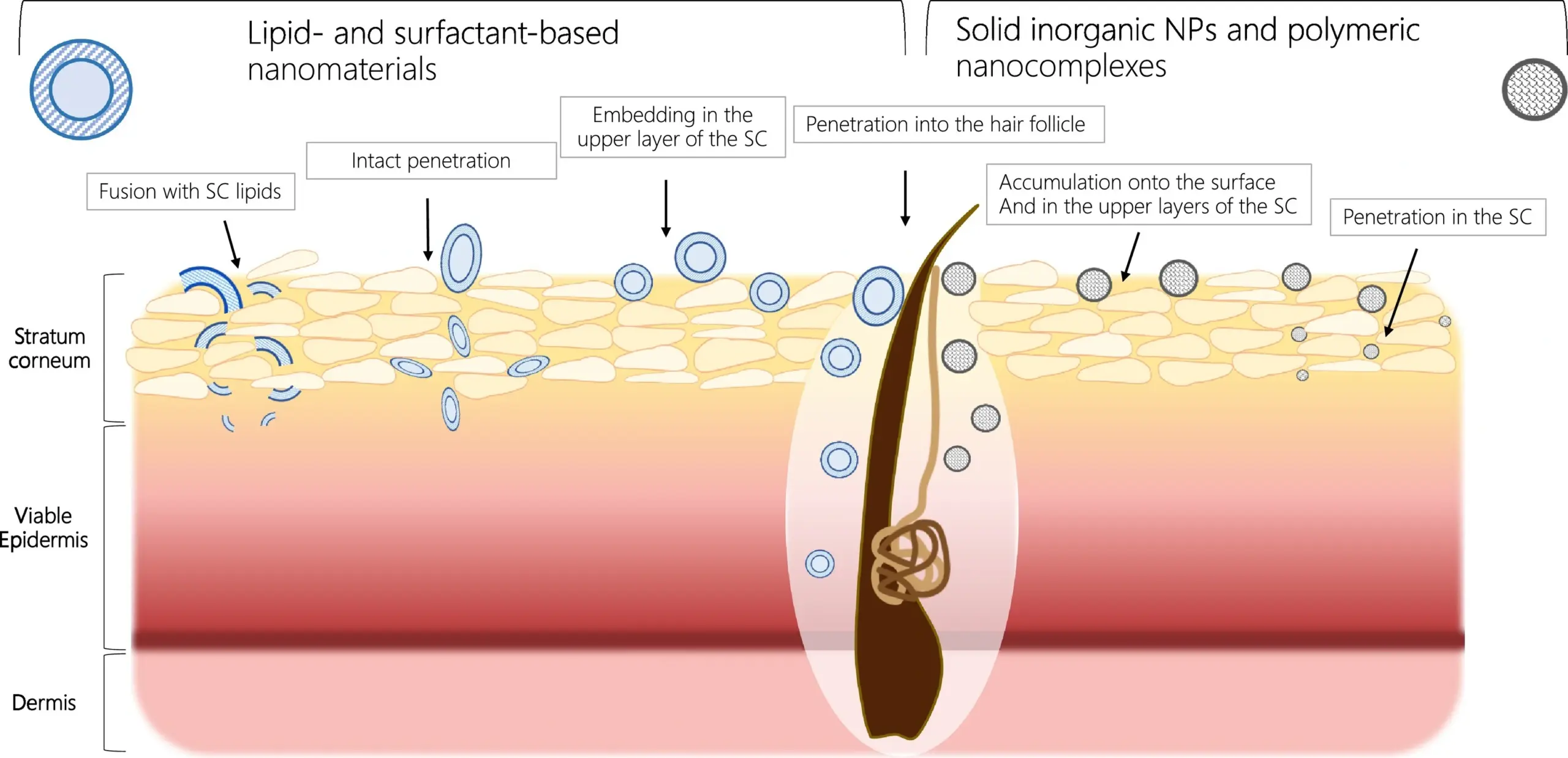
• Sunscreens and Sun Protection
Nano-sized titanium dioxide (TiO₂) and zinc oxide (ZnO) particles provide broad-spectrum UV protection without the white cast associated with traditional mineral sunscreens. These nanoparticles are photostable, non-comedogenic, and less likely to cause skin irritation.
Brand Example: Invisible Sun Protection with Nano-Minerals
Both Neutrogena Ultra Sheer and La Roche-Posay Anthelios sunscreens utilize nano-sized titanium dioxide (TiO₂) and zinc oxide (ZnO) to deliver broad-spectrum UVA/UVB protection—without the white cast traditionally associated with mineral sunscreens
Packaging Implications for Nano-Mineral Sunscreens:
- High-barrier tubes or airless pumps prevent oxidative degradation and maintain dispersion uniformity
- Non-reactive linings (e.g., aluminum-free laminate) to avoid ingredient interaction
- Opaque packaging to guard against light exposure, particularly UV-sensitive stabilizers
- Cleansers and Exfoliators
In modern skincare, cleansers and exfoliators are evolving beyond basic surfactants and scrubs. With the introduction of nanoparticles, active cleansing agents and exfoliants can now be encapsulated for controlled release, providing deep yet gentle skin renewal.
For example, nano-encapsulation helps:
- Prevent harsh stripping effects, especially on sensitive or acne-prone skin
- Deliver ingredients gradually, minimizing the“shock effect”common with traditional exfoliants
- Allow for dual-function formulas—cleansing and treatment in one
Packaging Requirements:
- Air-tight bottles or foaming pumps to preserve encapsulated particles
- pH-stable packaging for formulations using acidic exfoliants
- Transparent containers with UV coating, allowing product visibility without compromising stability
- Skin Tone and Texture Enhancement
Achieving a smooth, radiant complexion is a top priority in skincare—and nanotechnology plays a pivotal role in delivering brightening and texturizing agents with enhanced precision and efficacy.
By encapsulating active ingredients such as vitamin C, niacinamide, peptides, and silicones into nano-sized carriers, brands are able to:
- Improve ingredient penetration into deeper skin layers
- Protect sensitive actives (e.g., vitamin C) from oxidation and degradation
- Enable time-release delivery, ensuring consistent activity throughout the day
Packaging Considerations:
- Airless pumps or droppers to maintain ingredient potency
- Light-blocking materials to protect UV-sensitive brightening agents
- Multi-chamber packaging for formulas that combine exfoliants and brighteners separately

Hair Care
Nanotechnology is increasingly used in shampoos, conditioners, serums, and styling products to enhance the delivery of active ingredients to the hair shaft and scalp. Benefits include improved hydration, protection against environmental damage, and enhanced styling effects.
Brand Example:
Nanotechnology isn’t limited to facial care—it’s also being adopted by leading haircare brands like Pantene and Head & Shoulders to address scalp health, hair strength, and active delivery efficiency.
These brands use nanoparticles and nanoemulsions in select formulations to:
- Improve absorption of key ingredients like vitamins, zinc compounds, and plant extracts into the scalp
- Enhance bioavailability of anti-dandruff agents such as pyrithione zinc
- Deliver moisturizing and repairing ingredients deeper into the hair shaft, rather than sitting on the surface
For instance:
- Pantene’s advanced conditioners and serums utilize nano-lipid systems to replenish damaged cuticles and lock in moisture
- Head & Shoulders has experimented with nano-zinc particles, improving the efficacy and consistency of dandruff control treatments while maintaining scalp gentleness
Make-Up
• Foundations & Concealers
Nanoparticles—especially nano-silica, mica, and titanium dioxide—are used to improve:
Spreadability and blendability, creating a smooth, even application
Light-diffusion, softening the look of fine lines and pores
Skin adherence, helping products stay put without caking
Result: A more natural, airbrushed finish with lightweight wear.
Packaging Tip: Use air-tight pumps or squeeze tubes with UV-blocking materials to protect light-sensitive ingredients and maintain product consistency.
• Lipsticks & Lip Care
Nanoencapsulation is used to deliver:
Moisturizing agents (like shea butter, vitamin E) that penetrate deeper for long-lasting hydration
Color pigments with enhanced brightness and staying power
Active ingredients like SPF or plumpers with controlled release
Example: Brands like Clarins and L’Oréal use this in high-performance lip balms and long-wear lipsticks.
Packaging Tip: Sleek, twist-up tubes with inner lining to prevent ingredient oxidation and wax melt.
• Eye Makeup: Mascaras & Eyeshadows
Nanoemulsions and nanocapsules are used to:
Enhance color intensity in shadows
Improve smudge-resistance and water-resistance in mascaras
Increase adherence to delicate eye areas without irritation
Packaging Tip: Use sealed mascaras with precision wands and airtight shadow compacts to maintain product efficacy and prevent drying.
• Nail Care & Nail Polish
Nanoparticles are added to nail formulations to:
Increase gloss and smooth finish
Boost chip resistance and wear time
Enable self-leveling for salon-like application
Example: Brands like Revlon and Max Factor use nano-formulated polishes to improve shine and durability.
Packaging Tip: UV-resistant glass bottles and controlled-flow brushes help maintain the viscosity and quality of nano-enhanced lacquers.
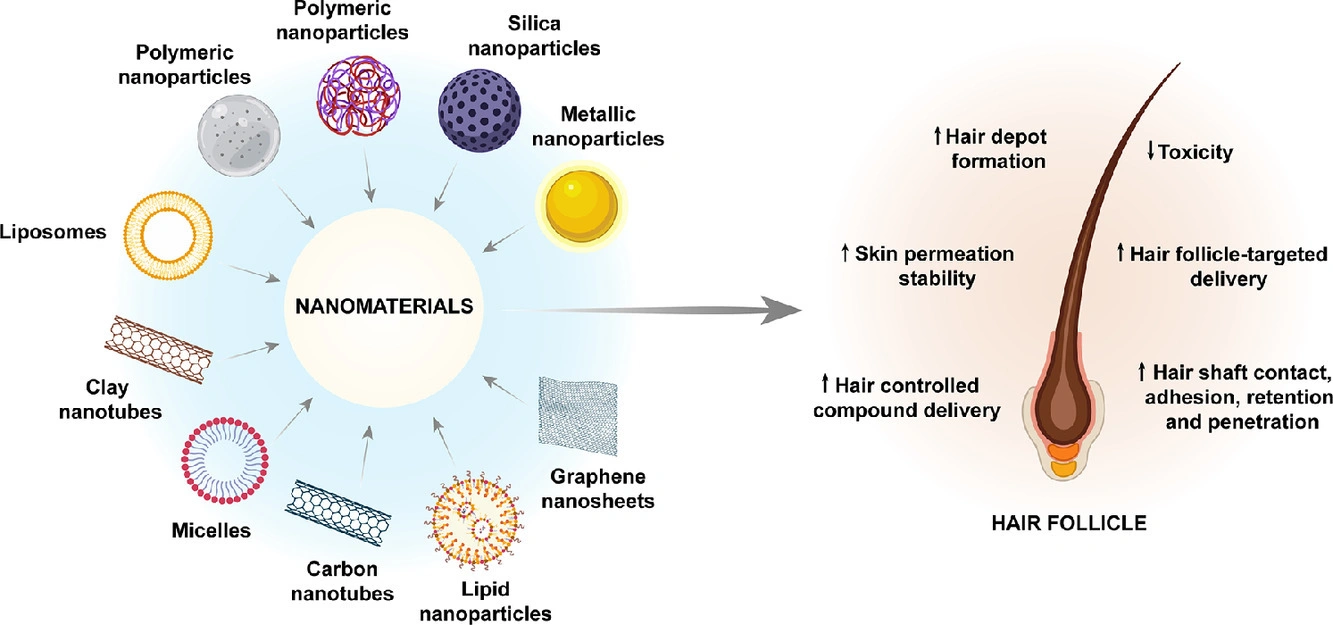
Sexual Well-Being and Intimate Care
Nanotechnology is increasingly finding its way into the sexual wellness and intimate care sector, enhancing product functionality, comfort, and safety. From lubricants to soothing gels, nano-formulations allow for better absorption, smoother textures, and targeted ingredient delivery—catering to sensitive areas with greater precision and care.
Applications Include:
Lubricants and moisturizers with nanoemulsified ingredients for faster absorption and long-lasting hydration
Intimate cleansing gels formulated with encapsulated antimicrobials or botanical extracts for improved pH balance and protection
Soothing or arousal gels using nanocarriers to deliver actives like CBD, menthol, or hyaluronic acid in a gentle and sustained manner
Packaging Implications:
Airless tubes or pump bottles to maintain hygiene and protect sensitive formulations
Single-use sachets or twist-cap ampoules for convenient, discreet application
Opaque and non-reactive packaging materials to preserve ingredient stability
Other Products
- Fragrances and Deodorants: Extended Freshness Through Nanotechnology
Nanotechnology is revolutionizing how scents linger and how odor is controlled. In fragrances and deodorants, nanoencapsulation techniques are used to:
Encapsulate fragrance molecules for controlled and prolonged release, offering a scent that evolves over time rather than dissipating quickly
Improve deodorant efficacy through nano-zinc oxide or silver nanoparticles with antibacterial properties that neutralize odor-causing bacteria
Packaging Considerations:
Pressurized or pump spray systems that preserve nano-fragrance integrity
Roll-on bottles with protective liners for formulations with nano-active odor blockers
Double-walled deodorant sticks for temperature-sensitive nano-ingredients
- Bath and Body Products: Enhanced Feel and Function
Nanotechnology improves the texture, delivery, and performance of body care products like lotions, washes, scrubs, and creams.
Applications include:
Nanoemulsions for lightweight, quick-absorbing lotions
Nanocapsules that release exfoliants, moisturizers, or antioxidants gradually
Improved foaming and rinsing properties for a more luxurious user experience
Packaging Implications:
Foam pumps and flip-top bottles that protect emulsions from contamination
Flexible barrier tubes that prevent oxidation and ingredient separation
Tinted or opaque bottles for formulations containing UV-sensitive actives
- Oral Care: Nano for a Cleaner, Whiter Smile
In oral hygiene, nanoparticles are now key to enhanced efficacy and targeted care in products such as toothpaste, mouthwash, and whitening gels.
Common nano-ingredients include:
Nano-hydroxyapatite to help remineralize enamel and reduce sensitivity
Silver or zinc nanoparticles for antimicrobial action
Nano-silica for gentle yet effective whitening without damaging enamel
Packaging Considerations:
Airless toothpaste pumps to avoid oxidation of active ingredients
Child-safe closures for nano-formulated fluoride products
Barrier-laminated tubes that extend product shelf life
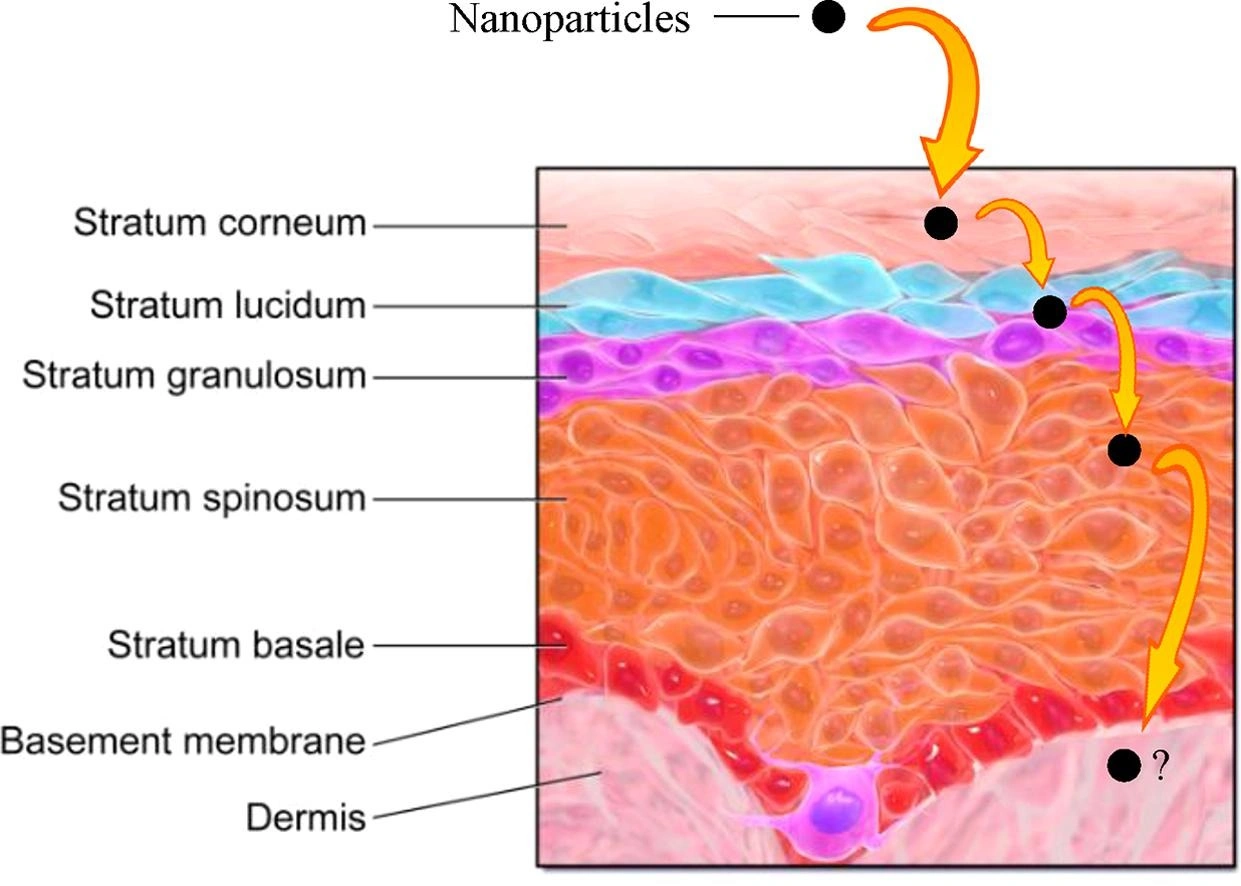
5. Key Advantages of Nanotechnology in Cosmetic and Personal Care Products
As the beauty and personal care industry pushes the boundaries of science and efficacy, nanotechnology has emerged as a powerful tool. Its integration across skincare, haircare, makeup, and hygiene products offers both brands and consumers a leap forward in performance, experience, and results.
Improved Penetration and Bioavailability
Unlike conventional ingredients, nanocarriers are small enough to cross the stratum corneum —the skin’s outermost barrier. This allows for deeper, more effective delivery of active ingredient, maximizing their efficacy and reducing wastage.
Enhanced Stability
Many actives—like vitamin C, retinol, and botanical extracts—are prone to degradation. Nanotechnology encapsulates these ingredients, shielding them from oxidation, UV light, and heat, thus extending shelf life and preserving potency.
Controlled and Sustained Release
Nanocarriers can release active ingredients gradually over time, reducing the need for frequent application and minimizing irritation or side effects. This is especially valuable in sensitive-skin or long-wear products.
Superior Sensory Experience
Nanoemulsions and nanoparticles improve texture, transparency, and spreadability, delivering lighter, smoother, and more elegant formulas that align with today’s aesthetic and sensorial preferences.
Targeted Delivery
Some nanocarriers are engineered to respond to environmental or biological triggers (e.g., pH, temperature), making possible “smart” skincare that releases actives only when and where needed—paving the way for personalized beauty solutions.
6. Benefits of Nanotechnology in Cosmetics
Nanotechnology is transforming the beauty industry by enabling smarter, safer, and more effective formulations. From skincare to color cosmetics and personal care, its benefits are reshaping consumer expectations and pushing innovation forward.
Increased Efficacy
Nanocarriers significantly enhance the delivery and absorption of active ingredients, ensuring they reach deeper layers of the skin or hair. This leads to more noticeable, faster results, even with traditionally unstable or hard-to-absorb compounds like retinol or vitamin C.
Longer-Lasting Effects
Thanks to controlled and sustained release mechanisms, nanotechnology ensures that actives continue to work long after application. This reduces the frequency of use while maintaining consistent benefits over time.
Reduced Irritation
Nanotech allows for lower concentrations of powerful ingredients, minimizing the risk of irritation, redness, or sensitization—especially for sensitive skin types. Gradual delivery also prevents “overdosing” the skin.
Green and Ethical Innovation
By improving delivery efficiency, fewer ingredients are required to achieve desired results—supporting cleaner labels and more eco-conscious formulations. Additionally, nanoencapsulation can extend product shelf life, reducing waste.
Customization and Precision
Nanotechnology enables personalized formulations, where actives are tailored to individual skin types, tones, or concerns. This paves the way for smart skincare and next-gen beauty solutions responsive to environmental or biological triggers.
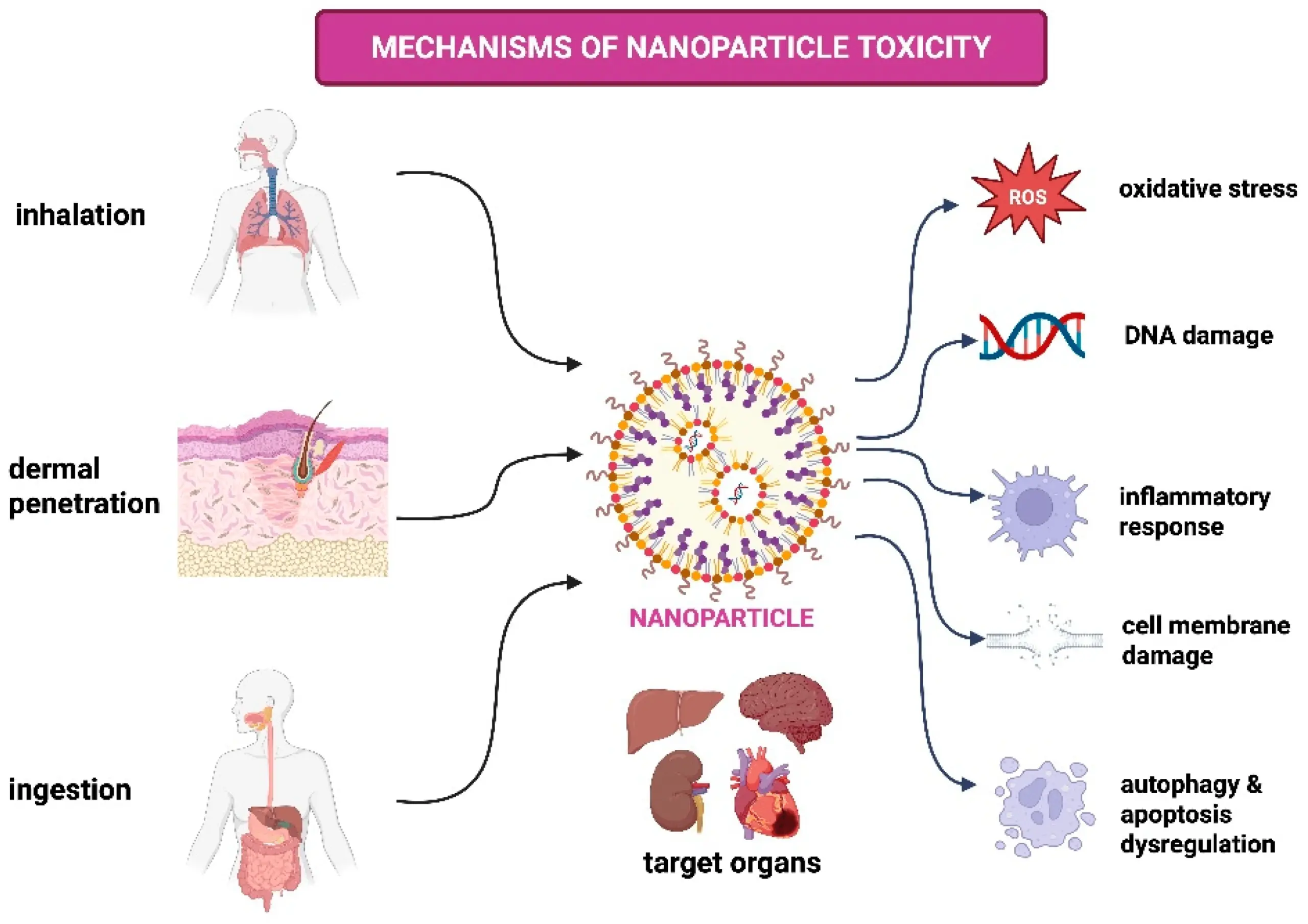
7. Safety, Risks, and Regulatory Considerations
Potential Risks
While nanotechnology offers many benefits, it also introduces new safety and regulatory challenges:
- Skin Penetration and Systemic Absorption: Nanoparticles may penetrate deeper into the skin, raising concerns about systemic exposure and accumulation in organs.
- Toxicity: Some nanoparticles, such as certain metal oxides, may induce oxidative stress, genotoxicity, or allergic reactions. The small size and high reactivity of nanoparticles require careful assessment of their toxicological profiles.
- Environmental Impact: The persistence and bioaccumulation of nanoparticles in the environment are not fully understood, necessitating further research.
Safety Assessment
Regulatory agencies require comprehensive safety testing, including:
- Sensitization and irritation tests (in vitro and in vivo)
- Permeability and absorption studies
- Genotoxicity and carcinogenicity assays
- Characterization of physicochemical properties (size, solubility, aggregation)
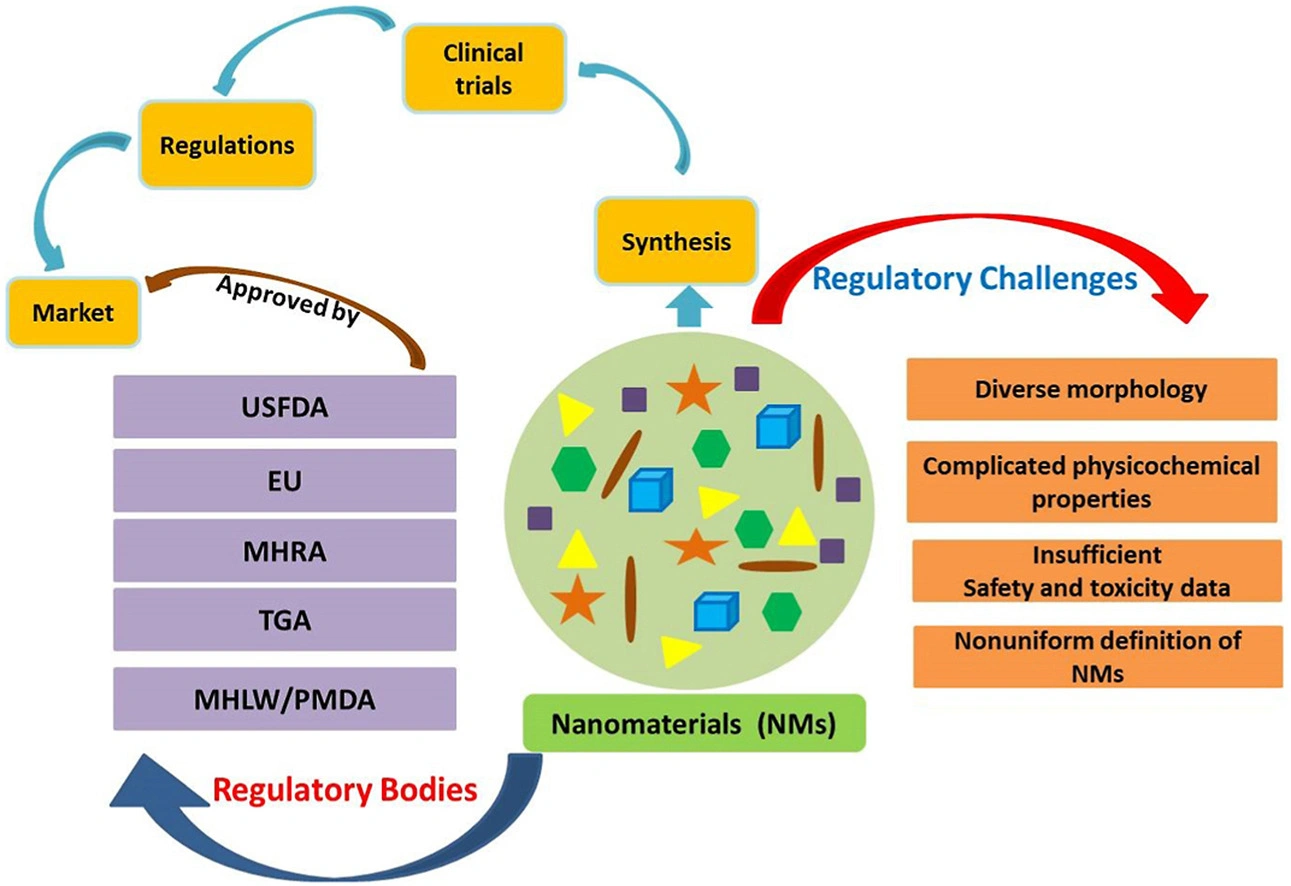
Regulatory Landscape
As nanotechnology becomes increasingly prevalent in beauty and personal care, regulatory oversight is evolving to address potential safety, transparency, and consumer trust concerns. Here’s how key markets are responding:
- European Union
The EU maintains one of the world’s most stringent regulatory frameworks for cosmetic products. Under the EU Cosmetics Regulation (EC) No. 1223/2009:
Nano-ingredients must be clearly labeled, with “\[nano]” following the substance name in the ingredients list.
From 2025, certain nanomaterials—such as nano-hydroxyapatite in oral care and select nano-metals—are prohibited due to safety concerns, particularly regarding inhalation or cellular toxicity.
EU regulations emphasize pre-market safety assessments, and the use of nanomaterials often requires notification to the Cosmetic Products Notification Portal (CPNP).
- United States
The U.S. FDA does not have specific laws governing nanotechnology in cosmetics, but it recommends rigorous safety evaluations. Companies are encouraged to consult the FDA’s Nanotechnology Guidance for Industry, which advises:
Evaluating whether a product contains engineered nanomaterials
Conducting risk assessments, especially when introducing nanoscale changes to conventional formulations
While not mandatory, compliance with FDA guidance is strongly encouraged to avoid enforcement actions or reputational risk.
- Global Harmonization Efforts
As international brands navigate differing regulatory regimes, there is growing momentum for harmonized global standards. Organizations like the OECD and ISO are working on nanomaterial definitions, test methods, and risk assessment protocols. Unified standards would:
Ensure consumer safety across borders
Streamline product development and packaging decisions
Facilitate trade and regulatory compliance in the expanding nanocosmetics market
8. Market Trends and Consumer Preferences
As nanotechnology reshapes the beauty landscape, it is also aligning closely with evolving consumer expectations and market shifts. Today’s beauty shoppers seek not only performance, but also ethics, personalization, and sustainability—and nanotech is emerging as a key enabler of these values.
Clean, Green, and Ethical Beauty
Consumers are increasingly drawn to products formulated with natural, organic, and cruelty-free ingredients. Nanotechnology enhances ingredient efficiency and stability, allowing brands to:
Use fewer synthetic additives
Maximize plant-derived actives
Create high-performance formulations aligned with clean beauty standards
It supports the development of “less-is-more” skincare—highly effective products with simplified, eco-conscious INCI lists.
Customization and Personalization
The rise of AI-driven skin analysis and nanocarrier innovation has opened the door to personalized skincare. Brands can now create:
Formulations that adapt to unique skin types and concerns
Products that adjust to real-time skin needs based on factors like environment or hormonal changes
Subscription models with tailor-made blends using nanoencapsulated actives
This trend enhances brand loyalty and meets rising consumer demand for bespoke beauty experiences.
Eco-Friendly Packaging Innovations
With heightened awareness around sustainability, brands offering nano-enhanced products are also investing in:
Recyclable or refillable packaging systems (e.g., airless refill cartridges)
Biodegradable materials that maintain barrier integrity
Packaging designs aligned with circular economy goals
The synergy between high-tech formulations and low-impact packaging is becoming a strong market differentiator.
Smart and Functional Cosmetics
“Smart beauty” is no longer futuristic. Stimuli-responsive nanocarriers are being engineered to release actives based on:
- pH shifts
- Temperature changes
- UV exposure
These adaptive formulations offer targeted, on-demand performance, giving consumers more intelligent, interactive products.

9. Future Directions: Smart, Sustainable, and Personalized Beauty
Smart Nanocarriers
Research is focused on “smart” nanocarriers that respond to environmental triggers (pH, temperature, enzymes) for on-demand release of actives. These systems promise greater precision and efficacy in treating specific skin concerns.
Green Nanotechnology
There is a strong push toward biodegradable, plant-based nanomaterials to minimize environmental impact and align with the values of eco-conscious consumers. Brands are also exploring refillable packaging and reduced ingredient lists enabled by the efficiency of nanocarriers.
AI and Customization
Artificial intelligence is being integrated with nanotechnology to analyze individual skin profiles and recommend or formulate personalized products. This trend is expected to dominate the future of skincare and cosmetics, offering consumers tailored solutions for their unique needs.
Expanded Applications
Beyond skincare and sun protection, nanotechnology is being explored for use in hair regeneration, anti-greying treatments, dental care, and even neurocosmetics—products designed to influence mood and sensory experience through the skin.
10. Challenges and Considerations
While nanotechnology offers tremendous benefits across beauty and personal care, it also presents unique challenges that must be addressed to ensure consumer confidence, product safety, and ethical development.
Consumer Education
Despite the science-backed benefits, many consumers remain uncertain or skeptical about the term “nano.” To build trust and drive adoption, brands must:
- Provide clear, transparent labeling
- Communicate the safety and efficacy of nano-based products
- Offer educational content that demystifies the technology
Well-informed consumers are more likely to embrace innovation—especially when it aligns with their health and ethical values.
Regulatory Harmonization
As previously noted, regulatory standards vary globally, creating complexity for brands operating across regions. Harmonization is needed to:
- Establish uniform safety assessments
- Simplify ingredient compliance and labeling
- Facilitate international trade and innovation in the growing nanocosmetics sector
Long-Term Safety and Environmental Impact
While short-term safety of many nanomaterials is well-documented, the long-term effects on human health and ecosystems require continued research. Key concerns include:
- Bioaccumulation in the body or environment
- Impact of nano-waste on water and soil
- Toxicological behavior of different particle shapes, sizes, and coatings
To address these, the industry must support:
- Ongoing scientific research
- Sustainable design of nanomaterials
- Transparent collaboration between regulators, academia, and manufacturers
11. Conclusion
Nanotechnology is transforming the cosmetics and skincare industry, unlocking new levels of efficacy, stability, and personalization. By enabling the targeted delivery of active ingredients, enhancing formulation longevity, and supporting the creation of smart, sustainable, and tailored solutions, nanotechnology addresses many of the limitations posed by traditional cosmetic science.
However, with great innovation comes responsibility. The rapid evolution of nanocosmetics must be supported by rigorous safety evaluations, transparent communication, and globally harmonized regulations to ensure both consumer trust and environmental stewardship.
As research progresses and consumer demand for performance and personalization grows, nanotechnology will continue to stand at the cutting edge of beauty innovation—delivering smarter, safer, and more effective products for the future of skincare and personal care.


